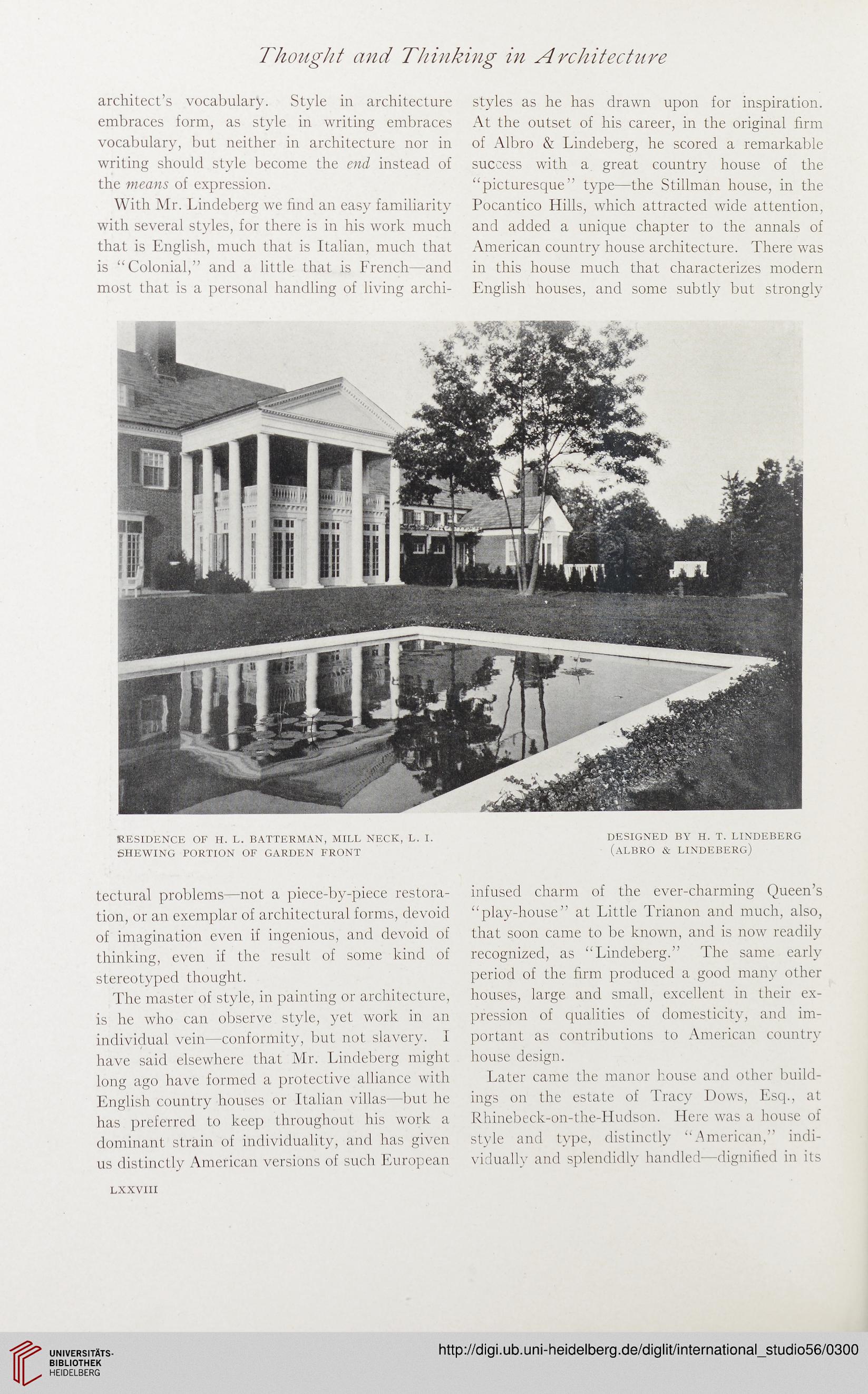Thought and Thinking in Architecture
architect’s vocabulary. Style in architecture
embraces form, as style in writing embraces
vocabulary, but neither in architecture nor in
writing should style become the end instead of
the means of expression.
With Mr. Lindeberg we find an easy familiarity
with several styles, for there is in his work much
that is English, much that is Italian, much that
is “Colonial,” and a little that is French—and
most that is a personal handling of living archi-
styles as he has drawn upon for inspiration.
At the outset of his career, in the original firm
of Albro & Lindeberg, he scored a remarkable
success with a great country house of the
“picturesque” type—the Stillman house, in the
Pocantico Hills, which attracted wide attention,
and added a unique chapter to the annals of
American country house architecture. There was
in this house much that characterizes modern
English houses, and some subtly but strongly
RESIDENCE OF H. L. BATTERMAN, MILL NECK, L. I.
SHEWING PORTION OF GARDEN FRONT
DESIGNED BY H. T. LINDEBERG
(ALBRO & LINDEBERG)
tectural problems—not a piece-by-piece restora-
tion, or an exemplar of architectural forms, devoid
of imagination even if ingenious, and devoid of
thinking, even if the result of some kind of
stereotyped thought.
The master of style, in painting or architecture,
is he who can observe style, yet work in an
individual vein—conformity, but not slavery. I
have said elsewhere that Mr. Lindeberg might
long ago have formed a protective alliance with
English country houses or Italian villas—but he
has preferred to keep throughout his work a
dominant strain of individuality, and has given
us distinctly American versions of such European
infused charm of the ever-charming Queen’s
“play-house” at Little Trianon and much, also,
that soon came to be known, and is now readily
recognized, as “Lindeberg.” The same early
period of the firm produced a good many other
houses, large and small, excellent in their ex-
pression of qualities of domesticity, and im-
portant as contributions to American country
house design.
Later came the manor house and other build-
ings on the estate of Tracy Dows, Esq., at
Rhinebeck-on-the-Hudson. Here was a house of
style and type, distinctly “American,” indi-
vidually and splendidly handled-—dignified in its
LXXVIII
architect’s vocabulary. Style in architecture
embraces form, as style in writing embraces
vocabulary, but neither in architecture nor in
writing should style become the end instead of
the means of expression.
With Mr. Lindeberg we find an easy familiarity
with several styles, for there is in his work much
that is English, much that is Italian, much that
is “Colonial,” and a little that is French—and
most that is a personal handling of living archi-
styles as he has drawn upon for inspiration.
At the outset of his career, in the original firm
of Albro & Lindeberg, he scored a remarkable
success with a great country house of the
“picturesque” type—the Stillman house, in the
Pocantico Hills, which attracted wide attention,
and added a unique chapter to the annals of
American country house architecture. There was
in this house much that characterizes modern
English houses, and some subtly but strongly
RESIDENCE OF H. L. BATTERMAN, MILL NECK, L. I.
SHEWING PORTION OF GARDEN FRONT
DESIGNED BY H. T. LINDEBERG
(ALBRO & LINDEBERG)
tectural problems—not a piece-by-piece restora-
tion, or an exemplar of architectural forms, devoid
of imagination even if ingenious, and devoid of
thinking, even if the result of some kind of
stereotyped thought.
The master of style, in painting or architecture,
is he who can observe style, yet work in an
individual vein—conformity, but not slavery. I
have said elsewhere that Mr. Lindeberg might
long ago have formed a protective alliance with
English country houses or Italian villas—but he
has preferred to keep throughout his work a
dominant strain of individuality, and has given
us distinctly American versions of such European
infused charm of the ever-charming Queen’s
“play-house” at Little Trianon and much, also,
that soon came to be known, and is now readily
recognized, as “Lindeberg.” The same early
period of the firm produced a good many other
houses, large and small, excellent in their ex-
pression of qualities of domesticity, and im-
portant as contributions to American country
house design.
Later came the manor house and other build-
ings on the estate of Tracy Dows, Esq., at
Rhinebeck-on-the-Hudson. Here was a house of
style and type, distinctly “American,” indi-
vidually and splendidly handled-—dignified in its
LXXVIII




